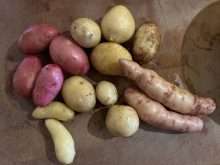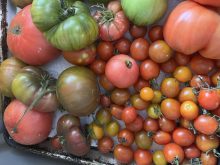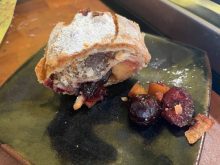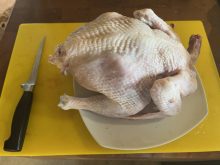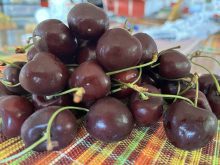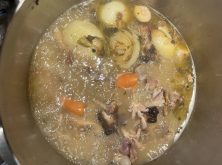When I arrived in Toronto in early November, I left winter behind. The skies were blue, the temperature a humid 23 C, about 40 degrees warmer than at home. My sister struck up the grill and I spatchcocked a chicken, rubbing it with garlic, fresh-cut thyme, spices and black olive paste. An hour later, we ate on the patio under the pergola. Former residents of Edmonton, my sister and brother-in-law still flinched when I told them about my recent near escapes while driving on icy Prairie highways, and they poured me an extra measure of wine as congratulations for keeping a cool head.
The following afternoon, my brother-in-law heroically drove me from the northernmost reaches of the Greater Toronto Area to the downtown core, rippling through rush-hour traffic with the aplomb of a Formula One pro. I arrived at Cirillo’s Academy, a kitchen “event space” with multiple stoves and workstations, in time to watch Cooks the Books, a cooking competition where culinary students worked in pairs to create a main course dish featuring beef. It was the preliminary to Taste Canada’s annual book awards, held a day later at the Fairmont Royal York hotel. The book awards were the reason for my Toronto visit — my essay collection, Bread & Water, was a finalist in the Culinary Narratives category.
The names of the 16 competing students were never revealed (other than the names of the two winning teams) but they came from culinary schools in Ontario and Quebec, plus a brave pair of high school teenagers. Each team had 45 minutes to prepare and cook their dish, with four judges and 100 wine-drinking onlookers analyzing their every move.
Read Also

Gentle treatments for pain in the neck
Heading toward year-end, people unknowingly tense up against the cold and busyness, causing neck pain that can often be treated with appropriate support and gentle mobility, athletic therapist Kathlyn Hossack says.
Cooking in such circumstances is fraught with stress. The simple presence of onlookers for unseasoned cooks still learning their chops can be a huge distraction. And some audience members offer noisy support to their chosen contestants, thinking it will spur them on when in reality it can be disrupting. And, as happened at this year’s Cooks the Books, one team had a loud “stage parent/coach” who, in my humble opinion, did more harm than good with their vehement exhortations. All the students, to their credit, remained calm and carried on, serving and describing their dish and its inspiration to the judges with composure. I was thrilled that half of those wearing cooks’ jackets were young women — when I was a young cook back in the day, girls were a small minority.
I was particularly interested in one dish that emulated a crepinette. In this traditional French dish, seasoned ground pork is shaped into a patty or tube and encased in caul fat (a lacy fat that encases animal organs and is used by cooks to contain such bundles). During roasting, the fat melts into the dish, adding flavour while keeping the shape tidy. The young cooks used a meat mallet to thinly pound flank steak, stuffed it with sauteed mushrooms and chives, and rolled it lengthwise using a sushi-rolling bamboo mat. The long cigar of meat was then encased in caul fat, seared and roasted before being carved. They did not win, but it looked stunning.
The following evening for the Taste Canada book awards ceremony, I took a page from the student cooks’ playbook. My sister and I rode the subway downtown, drank a glass of wine, observed the several hundred attendees attired in all manner of splendid clothing, and circumnavigated the ballroom as we awaited the start of the ceremonies. We kept calm. And when the MC read the title of my book as a winner, we carried on — in suitably excited style, complete with shrieks of excitement.
Later that evening, safely subway-ed home, we drank bubbly and toasted the occasion. I returned home to Saskatchewan — and winter — the next day. As I write this, an idea for a flank steak stuffed with olive paste and rolled into a fragrant cigar occupies my mind as the ideal fuel for Prairie cold. First we eat, then another toast. Salut!
Cooks the Books inspired flank steak
Choose a large, thin flank if you do not have a meat mallet. Great with roasted root vegetables and scalloped potatoes for an all-oven dinner. Serves 4-6
- 1 flank steak
- 1 head garlic, minced
- 1 tbsp. mustard
- 1 tbsp. maple syrup
- 1 tsp. hot chili paste
- 3 tbsp. olive oil
- 1⁄2 tsp. smoked paprika
- 1 tbsp. sweet paprika
- 1 tbsp. minced fresh thyme
- 1 cup finely minced, oil-cured black olives
- salt and pepper to taste
Preheat the oven to 425 F. Encase the steak in plastic and pound out with a meat mallet if you have one.
Mix remaining ingredients into a paste. Lay the steak out flat and season to taste. Evenly spread the paste over the meat. Roll up lengthwise and tie at intervals with butcher’s twine.
Heat an ovenproof saute pan, add the oil and sear the meat on all sides, then transfer pan to the oven. Roast until medium rare (an internal temperature of 140 F on an instant read thermometer). Remove from the oven and let stand for 10 minutes before carving.



